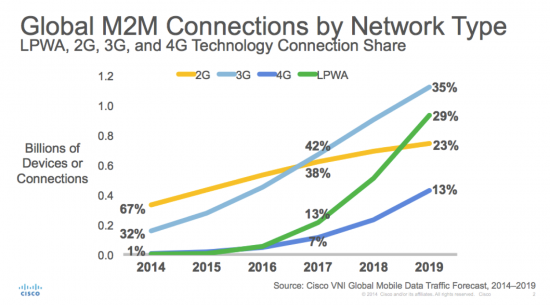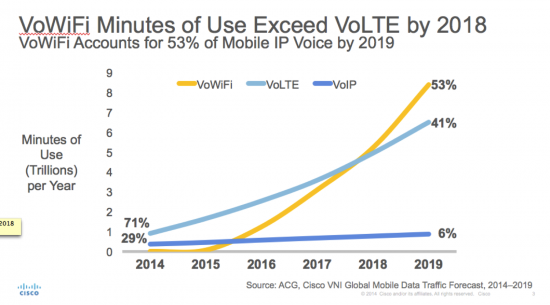































Updated 2015 VNI Mobile Forecast Reveals Potential "Wildcards" for Mobile Devices, Networks and Services
This week, Cisco released its annual Visual Networking Index (VNI) Global Mobile Data Forecast, 2014 -2019. Among the traditional top-line growth projections that indicate a healthy mobile industry (e.g., more than 5.2 billion global mobile users by 2019 and 10-fold mobile traffic growth over the next five years), there were several interesting trends that could have significant implications for mobile networking in the near future.
Mobile Devices: Laptops make a comeback and phablets start to emerge
While there is an overall growth in the number of mobile devices and connections, there is also a visible shift in the device mix. This year forecast shows a slight slowdown in the growth of tablets as a new device sub-category, phablets (included in our smartphone category), were began to show global adoption. Tablet growth was also affected by the introduction of lightweight laptops, which are quite similar to tablets in form factor but have more enhanced capabilities. Today, tablets are primarily being used as content consumption devices -ideally suited for video viewing in particular. Laptops are still serving as the dominant content creation device, particularly for business users (e.g., presentation, spreadsheet, and document development). While the absolute numbers or volume for smartphones (4.6 billion by 2019), tablets (nearly 300 million by 2019) and laptops (nearly 250 million by 2019) are growing, they are all losing their percentage share of total mobile devices and connections to the fastest growing mobile connection type -M2M (3.2 billion by 2019).

Mobile Networks: Low Power, Wide-Area (LPWA) networks may be optimal for campus-wide IoE applications
This year's forecast includes M2M nodes connected via Low-Power, Wide-Area (LPWA) networks. These networks areopening new M2M use cases by delivering an optimized ultra-narrowband solution that can support a wide area of coverage with minimal power consumption and connectivity costs. LPWA solutions are opening a host of new Internet of Everything (IoE) use cases for mobile network operators (MNOs) that could not have been addressed by cellular networks alone (early adoption has been seen in the healthcare and utilities industries). In the context of total global mobile devices and connections, the share of LPWA connections (all M2M) will grow from less than a tenth of a percent in 2014 (less than 1 million connections) to 8 percent by 2019 (933 million connections). When viewed strictly from a global M2M mobile connection perspective, the impact of LPWA is even more significant (see below).

Mobile Services: Vo-WiFi primed for growth as a viable mobile voice application
Several global mobile carriers have recently launched or announced their intent to deliver voice-over-Wi-Fi (VoWi-Fi) services. Voice over Wi-Fi is not a new concept, but earlier solutions had limitations that inhibited broad adoption and sometimes delivered a less than optimal end-user experience. Since then, VoWi-Fi enhancements now make it a carrier-grade application (more stable, reliable and secure). This service can now be offered independent of the hardware capabilities of the device as long as the device has Wi-Fi enabled on it, even non-SIM devices such as Wi-Fi-only tablets can have this service turned on. Today, VoWi-Fi can extend the reach of MNOs by enabling them to deliver a cost-effective, scalable, and quality solution for delivering in building coverage, where cellular coverage might be sketchy. This year's VNI Mobile Forecast predicts that VoWi-Fi will surpass voice over LTE (VoLTE) in terms of minutes of use by 2018. By 2019, VoWi-Fi will have 53 percent of mobile IP voice, up from less than a tenth of a percent in 2014.

We classify these trends as wildcards because they will undoubtedly be impacted by continued mobile technology innovation, regulatory decisions, and business model execution. In any case, we predict that these three trends will play a role in re-shaping the mobile landscape over the next five years.
Additional VNI Mobile Forecast Resources:
 Tags quentes :
Cisco VNI
visual networking index
M2M
mobile devices
mobile vni
mobile data traffic
global mobile data
mobile users
mobile to mobile connections
Tags quentes :
Cisco VNI
visual networking index
M2M
mobile devices
mobile vni
mobile data traffic
global mobile data
mobile users
mobile to mobile connections